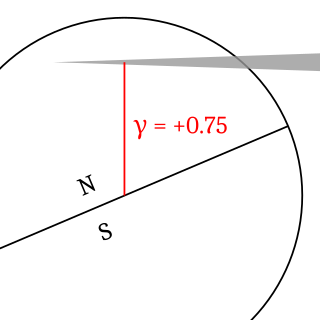Related Research Articles
Astronomical year numbering is based on AD/CE year numbering, but follows normal decimal integer numbering more strictly. Thus, it has a year 0; the years before that are designated with negative numbers and the years after that are designated with positive numbers. Astronomers use the Julian calendar for years before 1582, including the year 0, and the Gregorian calendar for years after 1582, as exemplified by Jacques Cassini (1740), Simon Newcomb (1898) and Fred Espenak (2007).

In astronomy, the new moon is the first lunar phase, when the Moon and Sun have the same ecliptic longitude. At this phase, the lunar disk is not visible to the naked eye, except when it is silhouetted against the Sun during a solar eclipse.
The saros is a period of exactly 223 synodic months, approximately 6585.321 days, or 18 years, 10, 11, or 12 days, and 8 hours, that can be used to predict eclipses of the Sun and Moon. One saros period after an eclipse, the Sun, Earth, and Moon return to approximately the same relative geometry, a near straight line, and a nearly identical eclipse will occur, in what is referred to as an eclipse cycle. A sar is one half of a saros.

Fred Espenak is a retired emeritus American astrophysicist. He worked at the Goddard Space Flight Center. He is best known for his work on eclipse predictions.
A total lunar eclipse took place on Tuesday, July 6, 1982, the second of three total lunar eclipses in 1982, and the only one that was in the descending node. A dramatic total eclipse lasting 1 hour and 46 minutes plunged the full Moon into deep darkness, as it passed right through the centre of the Earth's umbral shadow. While the visual effect of a total eclipse is variable, the Moon may have been stained a deep orange or red colour at maximum eclipse. This was a great spectacle for everyone who saw it. The partial eclipse lasted for 3 hours and 56 minutes in total.

A total lunar eclipse took place on Sunday, July 26, 1953.

A penumbral lunar eclipse will take place on June 15, 2049.

A total lunar eclipse will take place on January 1, 2048. It will be the first recorded lunar eclipse to be visible on New Year's Day for nearly all of Earth's timezones. The next such eclipse will occur in 2094.

A partial lunar eclipse will take place on January 22, 2046.

A penumbral lunar eclipse will take place on March 3, 2045.

A partial lunar eclipse will take place on July 18, 2046.

A partial lunar eclipse will take place on June 26, 2048. The Moon will be strikingly shadowed in this deep partial eclipse lasting 2 hours and 39 minutes, with 63.88% of the Moon in darkness at maximum.

A total lunar eclipse will take place on January 12, 2047.

A penumbral lunar eclipse will take place on May 17, 2049.

A total lunar eclipse will take place on April 26, 2051.

A total lunar eclipse will take place on October 30, 2050.

A total lunar eclipse will take place on May 6, 2069. The eclipse will be a dark one with the southern tip of the Moon passing through the center of the Earth's shadow. This is the first central eclipse of Saros series 132.

Gamma of an eclipse describes how centrally the shadow of the Moon or Earth strikes the other body. This distance, measured at the moment when the axis of the shadow cone passes closest to the center of the Earth or Moon, is stated as a fraction of the equatorial radius of the Earth or Moon.
A tropical year or solar year is the time that the Sun takes to return to the same position in the sky – as viewed from the Earth or another celestial body of the Solar System – thus completing a full cycle of astronomical seasons. For example, it is the time from vernal equinox to the next vernal equinox, or from summer solstice to the next summer solstice. It is the type of year used by tropical solar calendars.
Éphéméride Lunaire Parisienne is a lunar theory developed by Jean Chapront, Michelle Chapront-Touzé, and others at the Bureau des Longitudes in the 1970s to 1990s.
References
- 1 2 "(2213) Meeus". Minor Planet Center . International Astronomical Union . Retrieved 25 May 2018.
- 1 2 3 Meeus, Jean (1997). Mathematical Astronomy Morsels. Richmond, Virginia: Willmann-Bell. p. (Author Biography). ISBN 0-943396-51-4.
- ↑ Wolff, S.; Fraknoi, A. (June 1986). "Jean Meeus received the Amateur Achievement Award of the Astronomical Society of the Pacific". Mercury. 15 (5). Astronomical Society of the Pacific: 142–3. Bibcode:1986Mercu..15R.142W.
- ↑ Espenak, Fred; Meeus, Jean (October 2006). "Five Millennium Canon of Solar Eclipses: -1999 to +3000". Eclipse Web Site. NASA.
- ↑ Espenak, Fred; Meeus, Jean (January 2009). "Five Millennium Canon of Lunar Eclipses: -1999 to +3000". Eclipse Web Site. NASA.